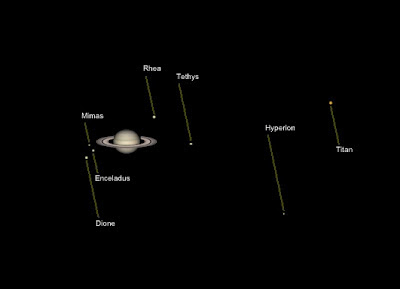 |
| Simulated view of Saturn and some of its moons as they appeared at 10:15 PM EDT, June 16, 2012. Image generated using "Gas Giants" for iPad. |
The afternoon and evening of June 16 offered up skies that were mostly-cloudy to overcast. I thought there was little chance we would be able to provide Public Night visitors with views of Saturn at Stephens Memorial Observatory. I arrived at the appointed hour and the sky looked poor but, in the distance, there appeared to be clearing. Just as twilight grew dim enough for Saturn and neighboring Spica to appear, the clouds thinned. A little late, the celestial pair began to twinkle through the milky sky and, with the help of a sharp-eyed attendee, was able to aim the telescope and immediately get decent views. Starting at low power then, at last, boosting the magnification to 208X, those who ventured out under doubtful skies were rewarded with fine views of the ringed world. Sightings of moons were difficult though one or two could be spotted near Saturn. We spotted Rhea and Enceladus, as best I can determine, in the high-powered, narrow-angle view. Despite the sky conditions, Saturn shown through and many of the same features seen on the previous night could again be seen! There were glimpses of atmospheric banding, Saturn's shadow was seen on its rings, the "F" ring was visible against the planetary disk, and --this surprised me-- we were getting glimpses of the Cassini Division within the ring system. While the Saturday night sky was not as clear as Friday's, the seeing was steadier which made up for some of the deficiencies. Temperature was about 80 degrees F. Only eight visitors passed through our doors but everyone got very nice views of Saturn, 858 million miles distant, and left happy they took the chance on the sky. Sky conditions did not allow views of fainter objects. Saturn began to fade from view at about 10:30 as clouds thickened, no other visitors arrived, so we closed up.



